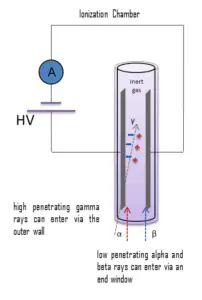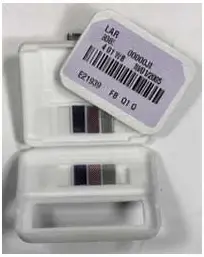Portable survey meters are radiation detectors used by radiological technicians to measure ambient dose rate. These portable instruments usually have rate meters. In nuclear facilities, these portable survey meters are typically used by radiation protection technicians, which are responsible for following operations in the field to help assure that radiation protection policies are carried out and that jobs are implemented in accordance with the ALARA principle. Their responsibilities include:
- Providing assistance and advice to workers to motivate them to adopt an ALARA behaviour.
- Following jobs to ensure the respect of safety and radiation protection procedures.
- In some plants, stopping work in case of serious deviation from dosimetric objectives, or when there is a significantly increasing radiological risk for workers.
The typical radiation survey meter is, for example, the RDS-31, which is a multi-purpose radiation survey meter that uses a G-M detector. It has optional alpha, beta, and gamma external probes. It measures 3.9 x 2.6 x 1.3 inches and can be handheld, or worn by pocket, belt clip, or pouch. It has a five-digit, backlit, LCD display. Geiger counters operate at such a high voltage that the size of the output pulse is always the same, regardless of how many ion pairs were created in the detector. Geiger counters are mainly used for portable instrumentation due to its sensitivity, simple counting circuit, and ability to detect low-level radiation. Although the major use of Geiger counters is probably in individual particle detection, they are also found in gamma survey meters. They are able to detect almost all types of radiation, but there are slight differences in the Geiger-Mueller tube.
The operational quantities for area and individual monitoring of external exposures are defined by the ICRP. The operational quantities for area monitoring are:
- Ambient dose equivalent, H*(10). The ambient dose equivalent is an operational quantity for area monitoring of strongly penetrating radiation.
- Directional dose equivalent, H’ (d,Ω). The directional dose equivalent is an operational quantity for area monitoring of weakly penetrating radiation.
See also: Work Management to Optimise Occupational Radiological Protection at Nuclear Power Plants. NUCLEAR ENERGY AGENCY, OECD 2009. ISBN 978-92-64-99089-0.
See also: The Radiation Dosimeters for Response and Recovery Market Survey Report. National Urban Security Technology Laboratory. SAVER-T-MSR-4. <available from: https://www.dhs.gov/sites/default/files/publications/Radiation-Dosimeters-Response-Recovery-MSR_0616-508_0.pdf>.
High-pressure Ionization Chamber – Gamma Survey Meter
Ion chambers may be also used as the Emergency Gamma Survey Meter, the Beta Survey Meter, and the Tritium-in-Air Monitor. They are very useful for high levels of gamma radiation. But in this case, there are some difficulties.
 Gamma rays have very little trouble in penetrating the metal walls of the chamber. Therefore, ionization chambers may be used to detect gamma radiation and X-rays collectively known as photons, and for this the windowless tube is used. Ionization chambers have a good uniform response to radiation over a wide range of energies and are the preferred means of measuring high levels of gamma radiation. Some problems are caused by the fact, that alpha particles are more ionising than beta particles and than gamma rays, so more current is produced in the ionization chamber region by alpha than beta and gamma. Gamma rays deposit significantly lower amount of energy to the detector than other particles.
Gamma rays have very little trouble in penetrating the metal walls of the chamber. Therefore, ionization chambers may be used to detect gamma radiation and X-rays collectively known as photons, and for this the windowless tube is used. Ionization chambers have a good uniform response to radiation over a wide range of energies and are the preferred means of measuring high levels of gamma radiation. Some problems are caused by the fact, that alpha particles are more ionising than beta particles and than gamma rays, so more current is produced in the ionization chamber region by alpha than beta and gamma. Gamma rays deposit significantly lower amount of energy to the detector than other particles.
The efficiency of the chamber can be further increased by the use of a high pressure gas. Typically a pressure of 8-10 atmospheres can be used, and various noble gases are employed. For example, high-pressure xenon (HPXe) ionization chambers are ideal for use in uncontrolled environments, as a detector’s response has been shown to be uniform over large temperature ranges (20–170°C). The higher pressure results in a greater gas density and thereby a greater chance of collision with the fill gas and ion-pair creation by incident gamma radiation. Because of the increased wall thickness required to withstand this high pressure, only gamma radiation can be detected. These detectors are used in survey meters and for environmental monitoring.


